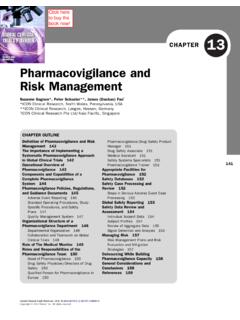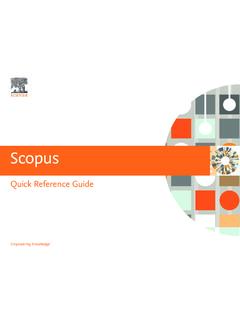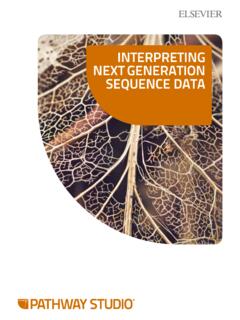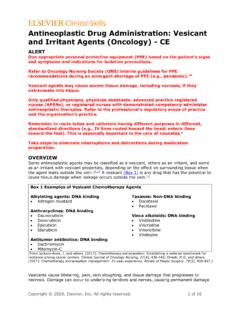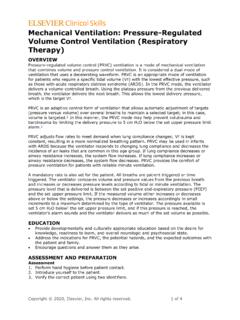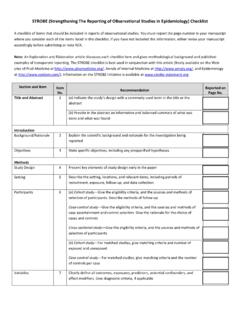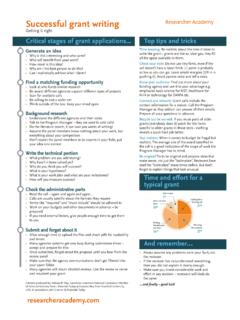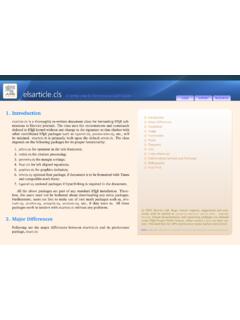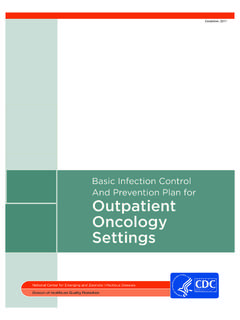Transcription of Cancer Research - Elsevier
1 CancerResearchCurrent Trends & Future DirectionsCancerResearchCurrent Trends & Future Directions3cancer Research current trends & future directionsThroughout history, progress of humankind can be measured by the achievements and milestones of each generation s new knowledge discoveries and their applications. Scientists, engineers, and inventors contributions have impacted and in most cases improved society and the human condition. Notably, given the knowledge and tools availa-ble at the time, sending men to the moon was one of these. The pre- vention and cure of most, perhaps all, Cancer would be this century s greatest achievement. With some cancers we have never been closer, while with others such a day currently seems in cell and molecular biology as well as biochemistry and genetics, and their application in medicine, have been the foundation for remarkable advances in health care, including Cancer . To anyone who has seen the wide-ranging impact of Cancer , both emotionally and financially, the goal of finishing the job the prevention and cure of cancers - is worth the investment and causes us to consider game-changing new ways in which we might undertake this effort.
2 The 16th century author and scientist Sir Francis Bacon once said knowledge itself is power. Greg Simon, Executive Director of the White House Cancer Moonshot Task Force, when speaking at Fortune s 2016 Brainstorm Health conference in San Diego, pointed out that, We still live in an information-scarce medical world. Thanks to the hard work of researchers, doctors, nurses, healthcare professionals, and the public advocates who support their efforts, early diagnosis and sophisticated new treatments for Cancer are now available, and promising new approaches are in the pipeline. But when it comes to Cancer , we have had periods of hope that ultimately proved to be unfounded. There is much more to be done, especially when considering that, just in the US, two of every three men and one of every three women will face Cancer of some type during their lives. Because of its privileged position in having developed Scopus, the largest and most comprehensive database of biomedical and clinical Research , Elsevier rightfully accepts the obligation to use this valuable tool to support and inform the future of Cancer Research .
3 In this report, we see the global landscape of Cancer Research . We hope to help us all see both the forest and the trees, and hopefully a straighter pathway forward. To get where we want to go, we first must take stock in where things stand and how things function currently. In this report, Elsevier , in association with the biomedical Research community, endeavors to characterize the Cancer Research landscape in the hope that it will provide helpful new Research current trends & future directionsIn association with the scientific community, Elsevier has produced a number of re-ports that have focused on important and emerging areas of Research . These include Stem Cell Research Trends and Perspectives of the Evolving International Landscape; Brain Science Mapping the Landscape of Brain and Neuroscience Research ; and Sustainability Science in a Global these cases, the full reports were written and produced prior to their open public release. In the case of this report on Cancer Research , we are motivated to take a different approach because of the importance and rapidly progressing nature of Cancer Research .
4 Individual draft installments of the Cancer Science Current Trends & Future Directions report will be produced and openly released for immediate use and input. Essentially, each installment is a type of pre-print that is a common practice in some disciplines and is being considered for adoption by initiative to speed up Cancer Research , currently called the " Cancer Moonshot," is administered through the White House. After the incoming administration devel-ops its priorities for its support for the initiative, we are looking forward to contin-uing to produce additional installments of the report. The nature and number of installments is not set and will be informed by input from the community and an advisory board. We anticipate four to six topic-specific installments plus an ana-lytical summary. Our hope is to release the full report by end of 2017. At the same time, The Lancet Oncology, an Elsevier publication, will produce a specially com-missioned issue focused on Cancer with direct contributions from leading Cancer researchers that will be published during the summer of report is being developed with Elsevier s Research Intelligence products and services; Research performance data comes from the Scopus database, which is approaching 1 million peer-reviewed publications and scientific proceedings on Cancer Research produced in the past completed, and in combination with other materials, this report on Cancer Research will offer the Research community, the public, policy makers, and Research funding organizations information at a new level of assessment on the current state of Cancer related Research .
5 We hope that this will be used to inform the development of new operational approaches, policies, and funding strategies at the laboratory, institutional, national, and international Research current trends & future directionsThis report is prepared and openly distributed by Elsevier as a service to the re-search community, policy makers, Research funders, and the s Research Intelligence collection of solutions is focused on providing objective analytical insights derived from the highest quality data available. This work is based on the Scopus database that is approaching 1 million peer-reviewed publications and scientific proceedings on the topic of Cancer Research produced in the past decade. The goal is to inform the selection of approaches, priorities, and strategies in order to produce new knowledge that will address the key challenges related to Cancer Research in the most effective, efficient, and impactful way possible. This first instalment presents an overarching view of emerging trends, many of which will be examined in greater detail in subsequent instalments.
6 The maps present the key countries and institutions which form the basis for analysis in this & Context6cancer Research current trends & future directionsMap of countries leading in Cancer Research output along with publication output, publication growth, and field-weighted citation impact (FWCI). World average (indicated by dashed circles) for publication growth: / World average for field-weighted citation impact: Data for publication output and field-weighted citation impact: 2014 / Data for publication growth: 5-year period (2010 2014). Source: ScopusCancer Research Output, Growth, and Impact in selected , , , ,653growthfwcipublications7cancer Research current trends & future , , , ,011growthfwcipublications8cancer Research current trends & future directionsMap of top Cancer Research institutes along with publication output, count of citations, and field-weighted citation impact (FWCI) 2011 2015. World average for field-weighted citation impact: Source.
7 ScopusCancer Research Output and Impact of top Cancer Research institutionsUniversity of TexasMD Anderson Cancer CenterHouston, TXcitationsfwcipublications10, ,253citationsfwcipublications4, ,545 University of Californiaat San FranciscoSan Francisco, CAcitationsfwciUniversity of MichiganAnn Arbor, MIpublications4, ,240citationsfwciMayo Clinic Rochester MNRochester, MNpublications3, ,902 University of British ColumbiaVancouver, BCcitationsfwcipublications3, ,461citationsfwciKarolinska InstitutetSolna, Swedenpublications3, ,583citationsfwcipublications3, ,685 University of Californiaat Los AngelesLos Angeles, CA9cancer Research current trends & future directionsbased on map from wikipedia / nuclearvacuum / cc by-sa UniversityCambridge, MApublications13, ,030citationsfwciNational Institutes of HealthBethesda, MDpublications8, ,329citationsfwcipublications6, ,470 Memorial Sloan KetteringCancer CenterNew York City, NYcitationsfwciJohns Hopkins UniversityBaltimore, MDpublications6, ,979citationsfwciDana-Farber Cancer InstituteBoston, MApublications3, ,953citationsfwciUniversity of TorontoToronto, ONpublications6, ,192citationsfwciUniversity of PennsylvaniaPhiladelphia, PApublications4, ,497citationsfwciUniversity of PittsburghPittsburgh, PApublications3, ,80610cancer Research current trends & future directions Cancer Research encompasses a broad array of re-search and includes a diverse range of specific Research topics.
8 Within this report, Cancer Research is defined as Research where the published results include Cancer or oncology within the title, abstract, or list of keywords of the publications, as indexed in the Scopus database. This includes all publication types, namely articles, reviews, conference papers, book chapters, notes, letters, short surveys, editorials, articles in press, erratum, books, conference reviews, business articles, and abstract re-ports. Articles represent 77% of the Research , and reviews represent 14% of the publications retrieved. The coun-tries selected for analysis produce the highest number of Cancer Research publications in 2014. Top Cancer Research institutions were identified by selecting the institutions with the highest number of citations in Cancer Research over the period 2014, Cancer Research represents over 4 % of all re-search performed globally, reflecting the huge amount of effort that has been invested worldwide to address this multifaceted and complex disease.
9 Today it is the leading cause of premature death in 28 European countries 1 and across the United States (US) 2. Worldwide, Cancer Research output has increased year on year over the past decade and has seen notable advances in our under-standing, diagnosis, and treatment of this disease. For example, to date, the US Food and Drug Administration has approved two vaccines (Gardasil, and later Cervar-ix) against Human Papilloma Virus (HPV), a virus that can cause cervical Cancer in women. While initially the vaccines were only approved for young women and girls, Research that linked HPV to a variety of other cancers led to the expansion of the vaccine recommendation to young men and boys as well. This single advance has cut cervical Cancer risk, making it one of the most prevent-able cancers. Similarly in 2001, Imatinib (Gleevec) was approved for the targeted treatment of a rare chronic myelogenous leukemia. By attacking specific molecular defects in patients while successfully sparing healthy cells, this treatment transformed a rare deadly Cancer from being a disease with an acute three to five year life expectancy, into a more chronic long-term, manageable condition.
10 Despite such advances, the impact of Cancer remains high and the number of cases is projected to nearly double over the next twenty years as the global population ages 3. Analysis of Cancer Research reveals that the US hosts a large fraction of the world s leading Cancer Research in-stitutions 4 (see Cancer Research Institutions Map) and can-cer Research output from the US represents the largest share of global output in the field (see Figure 1). The US share of Cancer Research has been declining over the past decade. This is largely the result of significant increase in China s Cancer Research publication output, which constitutes 17% of the global publication share in 2014, up from 5% in 2005 (see Figure 1). The impact of Cancer Research , which can be examined via field-weighted citation impact 5 (FWCI), has risen over the past decade for most of the countries included in this analysis. China has seen a particularly large increase in FWCI from just above in 2005 to above in 2014.
